|
|
|
Sort Order |
|
|
|
Items / Page
|
|
|
|
|
|
|
| Srl | Item |
| 1 |
ID:
108058
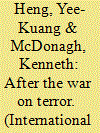

|
|
|
|
|
| Publication |
2011.
|
| Summary/Abstract |
In March 2009, the Obama administration sent a message to senior Pentagon staff instructing them to refrain from using either of the terms 'Long War' or 'Global War on Terror' and to replace these terms with 'Overseas Contingency Operations'. The change in tone and, potentially, substance, from the Obama White House by ending the 'war on terror' at the rhetorical level suggests a need to shift our academic attention towards developing more appropriate analytical frameworks for examining alternative strategies for countering terrorism. This paper seeks to explore what it terms an emerging risk-based approach being deployed by states. Our framework proposed here deploys the twin concepts of 'risk bureaucracies' and risk regulatory regimes (RRRs) in examining terrorist financing and aviation security regulations.
|
|
|
|
|
|
|
|
|
|
|
|
|
|
|
|
| 2 |
ID:
147804
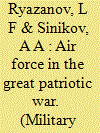

|
|
|
|
|
| Summary/Abstract |
The authors assess and analyze events of the Great Patriotic War involving aviation. The article shows how views on employing the Air Force in warfare changed, and highlights the role of the battle for air superiority.
|
|
|
|
|
|
|
|
|
|
|
|
|
|
|
|
| 3 |
ID:
166135
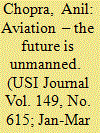

|
|
|
|
|
| Summary/Abstract |
Unmanned aircraft technologies have now matured. The world is at a transition. Dual use (optionally manned) aircraft are flying. Unmanned Combat Air Vehicles (UCAV) are being intensively used in combat with more and more drones being armed with air-to-surface weapons. Unmanned Aerial System (UAS) are taking-off and landing by themselves including on the moving aircraft carrier. Autonomous air refuelling has been tested. Unmanned stealth bombers are under development. Uninhabited helicopter convoys can be used for delivering supplies to troops deployed on combat front lines. Coordinated UAS swarms are already a reality and could also act as a multi strike decoy or jam the enemy defences through sheer numbers. UAS strikes will be a must to lead into territories with integrated air defences. UAS are now mostly being assigned the ‘Dull’, ‘Dirty’ and ‘Dangerous’ missions. UAS are also being used for missions like electronic attack or other non-lethal effects. By the year 2050 every conceivable mission, including heavy lift, would be unmanned. There are ethical and legal issues and also need for regulation. With no pilot inside, there is a risk of lowering the bar to using force. Also there is the risk of terrorists and non-state actors acquiring such assets. A casual hobbyist could by mistake fly a drone into an airliner. All these issues are being considered by regulators. Counter drone technologies are also evolving. India has to accelerate the development of Artificial Intelligence (AI) based weapon systems and platforms to stem excessive technological gap.
|
|
|
|
|
|
|
|
|
|
|
|
|
|
|
|
| 4 |
ID:
150387
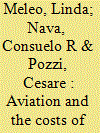

|
|
|
|
|
| Summary/Abstract |
The attention of policy makers on aviation environmental impacts has increased meaningfully over the last years. In order to limit the CO2 emissions in the transport sector, the EU has decided to include the aviation industry in the European Union Emission Trading Scheme (EU-ETS), from 1st January 2012 with the Directive 101/2008/EC.
|
|
|
|
|
|
|
|
|
|
|
|
|
|
|
|
| 5 |
ID:
115704
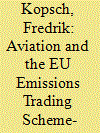

|
|
|
|
|
| Publication |
2012.
|
| Summary/Abstract |
Designing an emissions trading scheme requires in-depth knowledge regarding several aspects. This paper attempts to clarify some important design points of the forthcoming emissions trading scheme for aviation under the EU ETS. Five general key points of system design are acknowledged and comparisons are made to previous and current emission trading schemes. While it is not meant to be exhaustive it helps to create an understanding of what design elements should be handled with caution. Discussion is provided in regard to the recent implementation of aviation in the EU ETS. Above all, it is argued that initial allocations of emission permits and the trade barrier between the aviation sector and EU ETS need to be carefully examined.
|
|
|
|
|
|
|
|
|
|
|
|
|
|
|
|
| 6 |
ID:
156671
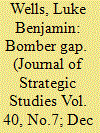

|
|
|
|
|
| Summary/Abstract |
For most of the 1950s, manned aircraft were the prime nuclear bomb delivery method, and were therefore a vital metric for British and American intelligence when calculating the Soviet threat. Each community reached very different conclusions from the same raw intelligence, generating the ‘bomber gap’ myth in the US but not in the UK. The information available was inconclusive, so in order to understand it estimators had to rely on their assumptions, which were different. Contrasting scopes for parochial capitalisation drew their conclusions further apart. Contrary to orthodox accounts of this episode, Soviet deception did not play a central role.
|
|
|
|
|
|
|
|
|
|
|
|
|
|
|
|
| 7 |
ID:
105081
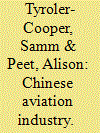

|
|
|
|
|
| Publication |
2011.
|
| Summary/Abstract |
The C919 program is representative of China's broader approach to advancing its aviation industry: dependence on foreign partnerships alongside investment in indigenous development. We find that this approach most closely fits the techno-hybrid model of technological development. This combination of techno-globalism and techno-nationalism is also found in the Aviation Industry Corporation of China's (AVIC) concept of indigenous innovation, macro strategy and structure, the controversy surrounding the recently revealed J-20 stealth fighter, and Chinese views of the potential for civil-military integration to aid in the development of a military airlifter. Truly indigenous development remains aspirational at this time, and the technological barriers that have caused China to depend upon international suppliers for the C919 project are also expected to inhibit domestic innovation and limit its impact on global aviation markets.
|
|
|
|
|
|
|
|
|
|
|
|
|
|
|
|
| 8 |
ID:
170815
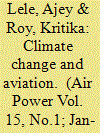

|
|
|
| 9 |
ID:
134024
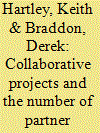

|
|
|
|
|
| Publication |
2014.
|
| Summary/Abstract |
Collaborative defence projects have been a distinctive feature of European defence industrial policy. This article focuses on whether the number of partner nations in international collaborative defence and aerospace programmes is a source of inefficiency. It appears that there is not a simple linear relationship. Two nation collaborations can be efficient, but conventional wisdom assumes that inefficiencies emerge with more than two partner nations. Inevitably, data problems made what appears to be a simple hypothesis difficult to test. The major result is that there is no evidence that efficiency as measured by development times is adversely affected by the number of partner nations. A limited sample regression and a comparison of Airbus vs. Boeing shows a similar conclusion.
|
|
|
|
|
|
|
|
|
|
|
|
|
|
|
|
| 10 |
ID:
079532
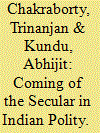

|
|
|
|
|
| Publication |
2007.
|
| Summary/Abstract |
Instead of searching for a definitive connotation of what is 'secular', the present essay explores how secular concepts gradually arrived on the scene of the Indian polity from a variety of areas and re-examines possibilities of probing the place of the secular in Indian polity by problematising its practice over time. Our methodology involves a shift of focus in searching for the roots of this concept in local and peripheral arenas rather than central texts and events. The dynamics of Indian centre-periphery relations have been dominantly historicised by the struggle for independence. This essay highlights the relevance of peripheral texts in defining secular aspects of polity, examining the dominant texts of the centre from the vantage point of the margin. While documenting an alternative discursive construction of secular politics in India, a sociologically informed reading on the question of 'the secular' argues that it will never dominate Indian politics without multiple challenges
|
|
|
|
|
|
|
|
|
|
|
|
|
|
|
|
| 11 |
ID:
152833
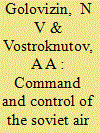

|
|
|
|
|
| Summary/Abstract |
The paper looks at the command and control systems of the 40th Army's Air Force in the Democratic Republic of Afghanistan (1979-1989); analyzes the makeup of the bodies, posts, forces, and assets of Air Force control; and highlights their impact on control of aerial formations and units in combat actions.
|
|
|
|
|
|
|
|
|
|
|
|
|
|
|
|
| 12 |
ID:
161646
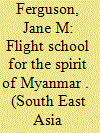

|
|
|
|
|
| Summary/Abstract |
In 1935, two Burmese filmmakers traveled to Tokyo with the intention of acquiring the latest sound recording equipment and training in sound-on-film production. In addition to these stated goals, in Japan they co-produced the feature film Japan Yin Thwe/Nippon Musume, ‘Japanese Darling.’ The film depicts daring young Burmese aviators and a budding romance with a Japanese woman. The active harnessing of the symbolic capital of aviation – the ideological notion of airmindedness – through the mimetic capacities of cinema, could be seen as a prescient example of Pan-Asianism, predating Daitoa Kyoeiken ‘Greater East-Asia Co-Prosperity Sphere’ propaganda. The film’s explicit encouragement of Burmese techno-nationalism offers a compelling contrast to other examples of anti-colonial nationalism, which emphasize notions of ethnic history and Buddhist morality and concerns of religious decline in the face of foreign imperialism. However, a comprehensive analysis of the film industry and commercial aviation in Japan in the 1930s reveals a structural impetus for this collaboration, arguably overshadowing ideological motivations and results.
|
|
|
|
|
|
|
|
|
|
|
|
|
|
|
|
| 13 |
ID:
094735
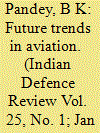

|
|
|
| 14 |
ID:
109049
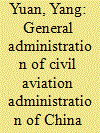

|
|
|
| 15 |
ID:
109282
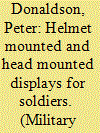

|
|
|
| 16 |
ID:
137614
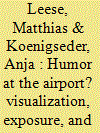

|
|
|
|
|
| Summary/Abstract |
With the emergence of aviation as a target for terrorism and serious crime in the 1970s, the affective dimension of airport security changed drastically and is now carefully engineered as a zone of earnest and solemn protocol. Against a backdrop of bombings and hijackings, airport security today enacts a “no bullshit” approach to the “war on terror.” Humor has essentially been banned from screening operations. From signs reading “No bomb jokes, please,” to drastic consequences in the case of non-compliance, security appears as something that is not to be fooled around with. Against this background, this paper builds on ethnographic fieldwork at Hamburg airport during the German trial run with body scanners in 2011. During the time of observation, we found a surprising amount of reciprocal laughter and joking. We argue that this can be conceptualized as an attempt to break open a space for laughter, momentarily abandoning protocol in order to deal with issues of visualization, exposure, and shame which arise from the new focus on the fleshly anatomical body.
|
|
|
|
|
|
|
|
|
|
|
|
|
|
|
|
| 17 |
ID:
108199
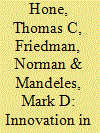

|
|
|
|
|
| Publication |
Newport, Naval war college press, 2011.
|
| Description |
xiv, 221p.
|
| Series |
Naval war college Newport paper 37
|
| Standard Number |
9781884733857
|
|
|
|
|
|
|
|
|
|
|
|
Copies: C:1/I:0,R:0,Q:0
Circulation
| Accession# | Call# | Current Location | Status | Policy | Location |
| 056305 | 387.7/HON 056305 | Main | On Shelf | General | |
|
|
|
|
| 18 |
ID:
042117
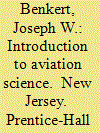

|
|
|
|
|
| Publication |
New Jersey, Prentice-Hall Inc, 1971.
|
| Description |
xx, 404p.Hbk
|
|
|
|
|
|
|
|
|
|
|
|
Copies: C:1/I:0,R:0,Q:0
Circulation
| Accession# | Call# | Current Location | Status | Policy | Location |
| 007887 | 629.13/BEN 007887 | Main | On Shelf | General | |
|
|
|
|
| 19 |
ID:
013957
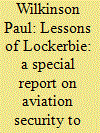

|
|
|
|
|
| Publication |
Dec 1989.
|
| Description |
1-30
|
|
|
|
|
|
|
|
|
|
|
|
|
|
|
|
| 20 |
ID:
183027
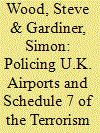

|
|
|
|
|
| Summary/Abstract |
Policing airports following 9/11 has been challenging with an emphasis on visibility and high levels of security checks for passengers. The focus has been on a form of ‘reassurance policing’ and an emphasis on procedural justice which is accepted as legitimate on the part of the public. However, there have been claims that that Muslim passengers are under greater suspicion than other passengers and have been subject to the practice of “racial profiling”. The powers under the Terrorism Act 2000, notably Schedule 7, have been under scrutiny as to the extent that they allow the police to stop and search suspects. This study reviews the opinions and experiences of young passengers at U.K. airports to see if they are reassured by policing and their opinions on profiling fellow passengers.
|
|
|
|
|
|
|
|
|
|
|
|
|
|
|
|
|
|
|
|
|